BNC Terminators
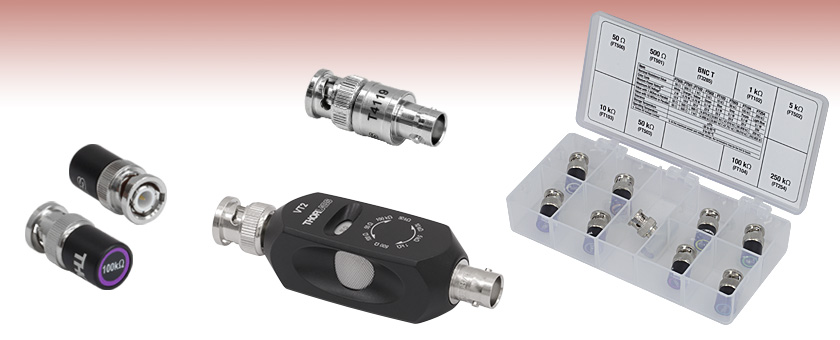
- Stub-Style or Feed-Through BNC Stub Terminators
- Resistance Values Ranging from 50 Ω to 250 kΩ
- Fixed and Variable Designs
- Fixed Terminator Kit Available
Back
Front
FT104
Fixed, 100 kΩ Stub Terminator
T4119
Fixed, 50 Ω
Feed-Through Terminator
FTK01
Fixed
Terminator Kit
(Not to Scale)
VT2
Variable Feed-Through
Terminator

Please Wait
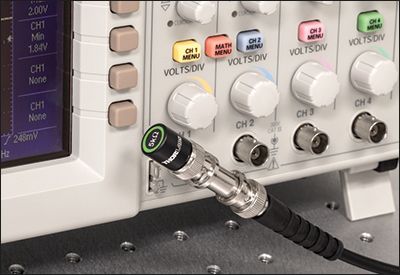
Click to Enlarge
A typical application for a stub-style BNC terminator is shown above. The FT502 5 kΩ terminator is connected via a T3285 BNC "T" adapter to an oscilloscope. A BNC cable connects the adapter to a biased photodetector (not shown). The detector (not shown) outputs a current based on the incident photon flux; the oscilloscope can then measure the voltage across the BNC terminator.
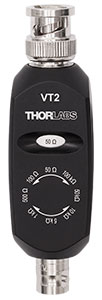
Click to Enlarge
The VT2 Variable Resistance Terminator offers eight different resistance values.
Features
- Feed-Through BNC Terminators
- Variable Resistance: 50 Ω to 100 kΩ
- Fixed 50 Ω Resistance
- Stub-Style Terminators
- Fixed Resistances Ranging from 50 Ω to 250 kΩ
- Terminator Kit with Eight Resistance Values from 50 Ω to 250 kΩ
Thorlabs' BNC terminators are available in both feed-through and stub styles. Our feed-through terminators provide an in-line solution while our stub-style terminators offer a compact solution.
When using a reverse biased photodiode, such as our packaged biased detectors, a photocurrent is produced when photons are absorbed. A load resistor is placed across the output of the detector, and the voltage drop across the resistor is measured by an oscilloscope or multimeter. A 50 Ω load is typically used to maximize the signal bandwidth, but higher voltages are produced by higher resistances at the expense of lower bandwidth. The image to the far right shows a typical application with our DET100A2 biased detector (not shown) and our FT502 5 kΩ stub-style terminator.
Thorlabs also includes our feed-through terminators in our electrical adapters kits, which also have a variety of BNC, SMA, and banana adapters.
| Posted Comments: | |
Mehrdad hosseini
(posted 2021-10-21 13:15:36.86) Hello,
I am going to buy BNC Terminators, but the limitation is up to 100k ohm.
Do you have any product with 1 mega ohm resistor? or can I ask you to design such a BNC terminator for me?
I would be grateful if you could guide me.
Best Regards,
Mehrdad cdolbashian
(posted 2021-11-08 04:50:46.0) Thank you for reaching out to us Mehrdad! We can potentially do this for you as a custom. I have reached out to you directly to work out the details. user
(posted 2021-06-16 12:17:57.33) Connect an SMA cable to the output end of the module,the he other end of SMA cable is connected to T4119,then connect T4119 and conditioning circuit,Does the input impedance of the circuit need to be considered in order to obtain the desired bandwidth cdolbashian
(posted 2021-08-19 04:12:06.0) Thank you for contacting us here at Thorlabs. I have reached out to you directly with regards to your specific application and corresponding inquiry. user
(posted 2013-08-16 15:14:26.38) Dear Thorlabs, is there an upper limit to the bandwidth of your terminators other than T4119 (500MHz) such as VT1 or FT500 + T3285? Often it ends up in the several hundred MHz range unless specialized sub-components/assembly are used. I'm looking for a terminator to use with your SV2-FC as suggested in its manual.
Regards,
Charles pbui
(posted 2013-08-27 12:11:00.0) Response from Phong at Thorlabs: BNC terminators are generally not recommended past 2 GHz. Both the VT1 and FT500 are not rated for 2GHz. We would recommend using an SMA terminator and a SMA Tee instead. The SV2-FC comes with an SMA output. For best results, we would recommend using a coaxial cable with SMA connectors and the detector should be directly terminated into the 50 Ohm input of an oscilloscope (no other external terminator used). Keep cables as short as possible, up to 4 feet should be no problem. You can find our SMA cables at http://www.thorlabs.com/newgrouppage9.cfm?objectgroup_id=2888. |

| VT2 Specifications | ||||
|---|---|---|---|---|
| Nominal Value |
Max Power Ratinga |
Max DC Voltage |
Value with 1 MΩ in Parallel |
Value with 100 MΩ in Parallel |
| 50 Ω | 1 W | 5 V | 50 Ω | 50 Ω |
| 100 Ω | 1 W | 8 V | 100 Ω | 100 Ω |
| 500 Ω | 0.25 W | 8 V | 500 Ω | 500 Ω |
| 1 kΩ | 0.25 W | 12 V | 1 kΩ | 1 kΩ |
| 5 kΩ | 0.25 W | 25 V | 4.98 kΩ | 4.99 kΩ |
| 10 kΩ | 0.125 W | 25 V | 9.90 kΩ | 9.99 kΩ |
| 50 kΩ | 0.125 W | 25 V | 47.72 kΩ | 49.75 kΩ |
| 100 kΩ | 0.125 W | 25 V | 90.91 kΩ | 99.00 kΩ |
| General VT2 Specifications | ||||
| Resistance Tolerance | ±5% | |||
| Storage Temperature | -30 to 60 °C | |||
| Operating Temperature | 10 to 40 °C | |||
Thorlabs offers two feed-through (in-line) terminators: the VT2 variable resistance terminator and the T4119 fixed 50 Ω terminator.
Variable Resistance BNC Terminator
This variable terminator allows the user to choose from eight discrete resistance values ranging from 50 Ω to 100 kΩ (see table to the right). Change the resistance by turning the dial inside the housing until the desired value appears in the window on the front of the housing. The resistance dial has two accessible grip points located on opposite sides of the housing. Please note that as the resistance is increased above 50 Ω the bandwidth will be decreased due to back reflections; at these higher resistance values, as the cable becomes longer the bandwidth will decrease further.
The variable resistance terminator is ideal for use with our biased photodetectors. For these photodetectors, a 50 Ω termination maximizes response time but can generate a low voltage in many coupling applications. The VT2 makes it convenient to switch to a higher resistance (and thus a higher voltage) while tweaking the system, and then down to a lower resistance for the maximum response time.
Fixed Resistance BNC Terminator
The T4119 is a 50 Ω feed-through terminator, which maximizes the signal bandwidth observable with our biased detectors. It can dissipate signals with input powers of 2 W (average at 25 °C) and frequencies up to 500 MHz.

Thorlabs' stub-style BNC terminators are compact and designed for switching between different resistors quickly. In addition, the resistors chosen have maximum power ratings that support the full 0 to 10 V output capability of our biased detectors. For measuring high-speed signals, it is best to use a 50 Ω terminator to maximize the bandwidth of the biased detector. The higher resistance values are ideal for measuring low bandwidth signals with our biased detectors, as the voltage across the resistor will be higher. Please note that as the resistance is increased above 50 Ω the bandwidth will be decreased; at these higher resistance values, as the cable becomes longer the bandwidth will decrease further.
When using these terminators, it is necessary to use a BNC "T" adapter, such as our T3285, to connect both the signal BNC cable and the terminator to the detector.
| Item # | FT500 | FT101 | FT501 | FT102 | FT502 | FT103 | FT503 | FT104 | FT254 |
|---|---|---|---|---|---|---|---|---|---|
| Nominal Resistance Value | 50 Ω | 100 Ω | 500 Ω | 1 kΩ | 5 kΩ | 10 kΩ | 50 kΩ | 100 kΩ | 250 kΩ |
| Label Color (Click for Photo) | White | Red | Orange | Yellow | Green | Blue | Gray | Purple | Light Blue |
| Maximum Power Ratinga,b | 2 W | 2 W | 0.75 W | 0.75 W | 0.1 W | 0.1 W | 0.1 W | 0.1 W | 0.1 W |
| Maximum DC Voltageb | 10 V | 14 V | 19 V | 25 V | 22 V | 25 V | 25 V | 25 V | 25 V |
| Value with 1 MΩ in Parallelc | 50 Ω | 100 Ω | 500 Ω | 999 Ω | 4.975 kΩ | 9.901 kΩ | 47.619 kΩ | 90.909 kΩ | 200 kΩ |
| Value with 10 MΩ in Parallelc | 50 Ω | 100 Ω | 500 Ω | 1 kΩ | 4.998 kΩ | 9.990 kΩ | 49.751 kΩ | 99.010 kΩ | 243.902 kΩ |
| Resistance Tolerance | ±5% | ||||||||
| Storage Temperature | -30 to 60 °C | ||||||||
| Operating Temperature | 0 to 60 °C | ||||||||

The FTK01 Stub-Style BNC Terminator Kit contains eight terminators with resistance values ranging from 50 Ω to 250 kΩ. One T3285 BNC "T" Adapter (F-M-F) is also included in the terminator kit. When using these terminators, it is necessary to use a BNC "T" adapter to connect both the signal BNC cable and the terminator to the detector. The terminators and adapter are packaged in a 7.0" x 3.5" x 1.25" (177.8 mm x 88.9 mm x 31.8 mm) plastic box with nine labeled compartments. This kit offers added savings over individual resistor purchases. The table below provides specifications for each BNC terminator.
| Resistor Item # | FT500 | FT501 | FT102 | FT502 | FT103 | FT503 | FT104 | FT254 |
|---|---|---|---|---|---|---|---|---|
| Nominal Resistance Value | 50 Ω | 500 Ω | 1 kΩ | 5 kΩ | 10 kΩ | 50 kΩ | 100 kΩ | 250 kΩ |
| Color Code | White | Orange | Yellow | Green | Blue | Gray | Purple | Light Blue |
| Maximum Power Ratinga,b | 2 W | 0.75 W | 0.75 W | 0.1 W | 0.1 W | 0.1 W | 0.1 W | 0.1 W |
| Maximum DC Voltageb | 10 V | 19 V | 25 V | 22 V | 25 V | 25 V | 25 V | 25 V |
| Value with 1 MΩ in Parallelc | 50 Ω | 500 Ω | 999 Ω | 4.975 kΩ | 9.901 kΩ | 47.619 kΩ | 90.909 kΩ | 200 kΩ |
| Value with 10 MΩ in Parallelc | 50 Ω | 500 Ω | 1 kΩ | 4.998 kΩ | 9.990 kΩ | 49.751 kΩ | 99.010 kΩ | 243.902 kΩ |
| Resistance Tolerance | ±5% | |||||||
| Storage Temperature | -30 to 60 °C | |||||||
| Operating Temperature | 0 to 60 °C | |||||||
 Products Home
Products Home









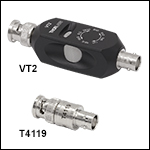
 Zoom
Zoom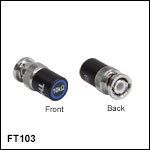
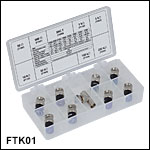
 BNC Terminators
BNC Terminators